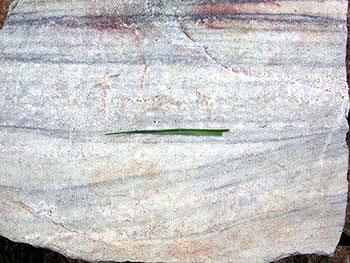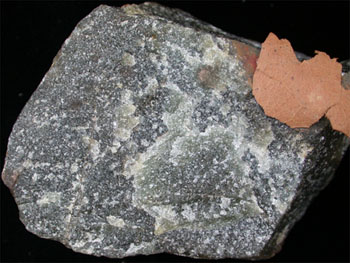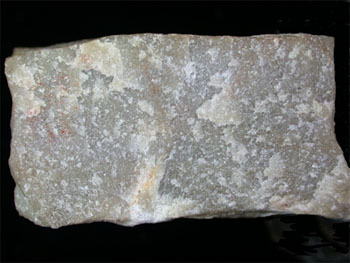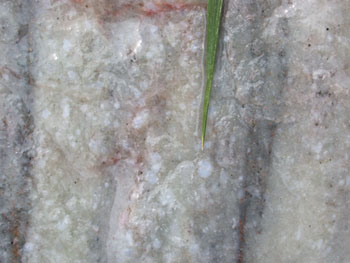Quartzite
| Quartzites form when quartz sandstones are metamorphosed. Quartzites often preserve original cross-bedding in the sandstone; sometimes deformation during metamorphism makes this cross-bedding look somewhat 'stirred'. The way to tell a quartz sandstone from a quartzite is when you break a quartzite, the fracture will cut right through the quartz grains. With a quartz sandstone, it is easier to break around the grains than through them. |
|
This quartzite sample shows the cross-bedding that is preserved in some quartzites. The cross-bedding was created when it was soft sandy sediment, preserved when it was turned to a hard sandstone, and still preserved when it was metamorphosed into quartzite.
The current flowed from right to left in this 700 million year-old sample from North Carolina.
|

|
|
If you enlarge this photo, you can see the remains of small sand grains plus, near the top, a layer of small pebbles (granules).
|

|
|
This is a typical quartzite seen in lab: even in enlarged view it is hard to see individual grains. But if you look at the enlarged view, you will see a typical surface texture of quartzite.
To verify that a quartzite sample is quartz and not, say, calcite, do a hardness test.
|

|
|
This is a green variety of quartzite. Click to see the close-up and you'll see the same surface texture as in the red quartzite above.
|

|
|
This is a tan/gray quartzite. See why we like to de-emphasize color when it comes to recognizing rocks and minerals? Again, the surface texture and hardness are distintive.
|

|
|
Since a quartzite is a metamorphosed quartz sandstone, how do you tell the two apart?
A handy way in the field is to see if a broken surface cuts across grains or around grains. In this wetted surface, the cloudy white blobs are pebbles/granules cut in half by the fracture. This is a quartzite. In a sedimentary rock, the grains would still be whole and sticking out from the surface.
|

|
|

![]()





